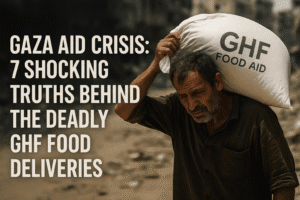Gaza Aid Crisis: 7 Shocking Truths Behind the Deadly GHF Food Deliveries
A desperate quest for food has turned deadly in Gaza. Hundreds of Palestinians (over 500 killed, 4,000 injured according to local health officials) have been killed or wounded trying to reach aid distribution sites run by the US and Israeli-backed Gaza Humanitarian Foundation (GHF). These sites operate inside Israeli military zones, a practice UN chief Guterres condemns as “inherently unsafe,” stating “the search for food must never be a death sentence.”
Eyewitnesses and reports allege Israeli forces fire on crowds, while Israel denies ordering deliberate attacks, citing “warning shots.” GHF boss Moore doesn’t deny nearby deaths but disputes blame, accusing the UN of spreading unverified claims. Trapped civilians now face an impossible choice: grapple with starvation or risk death trying to reach lifesaving aid funneled through active combat areas.

Gaza Aid Crisis: 7 Shocking Truths Behind the Deadly GHF Food Deliveries
The image is stark: a Palestinian man in Khan Younis, his face etched with fatigue, hauling a sack of GHF aid. It’s a symbol of desperate hope. Yet, this lifeline is now shrouded in controversy and bloodshed. The Gaza Humanitarian Foundation (GHF), a US and Israeli-backed aid group, finds itself defending its very existence after reports that hundreds of Palestinians have been killed or injured trying to reach its distribution points.
The Scale of the Tragedy: According to the Hamas-run Gaza Health Ministry, over 500 Palestinians have been killed and 4,000 injured attempting to access aid since GHF took over distribution. The incidents aren’t isolated. Within days of GHF starting operations in late May, dozens were killed on June 1st and 3rd alone. The near-daily reports of casualties near GHF sites – situated inside Israeli military zones – have drawn international alarm and condemnation.
A Clash of Narratives:
- The UN & Eyewitnesses: UN Secretary-General Antonio Guterres branded the GHF system “inherently unsafe,” stating, “Any operation that channels desperate civilians into militarized zones is inherently unsafe. The search for food must never be a death sentence.” Eyewitnesses and medics repeatedly describe Israeli forces opening fire on crowds near these aid points. A bombshell report in Haaretz quoted unnamed IDF soldiers claiming they were ordered to shoot unarmed civilians near aid sites to disperse them.
- Israel’s Denial: Prime Minister Benjamin Netanyahu called the Haaretz allegations “malicious falsehoods.” The IDF stated it “did not instruct the forces to deliberately shoot at civilians,” while acknowledging efforts to improve safety (adding fencing, signage, new routes). They often cite firing “warning shots” at perceived “suspects.”
- GHF’s Defense: GHF boss Johnnie Moore, speaking to the BBC, pushed back fiercely. While not denying deaths near aid sites, he contested the attribution: “100% of those casualties are being attributed to close proximity to GHF… that is not true.” He further claimed, “100% of the casualties are being attributed to the IDF – as best as we can tell that’s also not true.” Moore accused the UN of spreading unverified information and dishonesty, alleging widespread hijacking of UN aid trucks pre-GHF – a claim the UN refutes. He admitted GHF aid was “insufficient” but emphasized providing “50 million meals” where little existed before.
The Human Reality: An Impossible Choice The core insight here transcends the blame game: For Gaza’s starving population, the quest for food has become a lethal gamble. The fundamental flaw, as highlighted by the UN, is the location of aid distribution within active military zones. This forces civilians into an impossible dilemma:
- Option 1: Risk death or injury venturing into a militarized area for a chance at food.
- Option 2: Stay “safe” and face starvation or malnutrition.
The Verification Vacuum: Compounding the tragedy is the near-total lack of independent verification. Israel’s blockade prevents international journalists, including the BBC, from entering Gaza. This vacuum allows conflicting narratives to flourish unchecked, making it incredibly difficult to ascertain the precise circumstances of each incident or hold actors definitively accountable.
Aid Still Falls Short: Despite GHF’s distribution and Israel’s partial easing of an 11-week blockade, the volume of aid entering Gaza remains grossly inadequate. Experts warn famine still looms. GHF’s touted 50 million meals equate to less than one meal per person per day since operations began – a stark illustration of the gap between need and provision.
The Funding Dilemma: Amidst this turmoil, the US State Department announced $30 million in funding for GHF – its first known direct contribution. This investment highlights the desperate need for aid channels but also raises profound ethical questions about funding an operation deemed “inherently unsafe” by the UN and linked to such devastating civilian casualties.
The Unanswered Question: Johnnie Moore stated, “The mission is clear. We just want to feed Gazans.” The UN, Israel, and presumably GHF share this stated goal. Yet, the horrific death toll around aid sites persists. The critical question isn’t just about intent, but about method: Can feeding people safely coexist with funneling them through active combat zones? Until this fundamental contradiction is resolved, the image of that man carrying his aid sack will remain a symbol not just of hope, but of unbearable risk and systemic failure. The search for food, tragically, continues to carry a death sentence for far too many.
You must be logged in to post a comment.